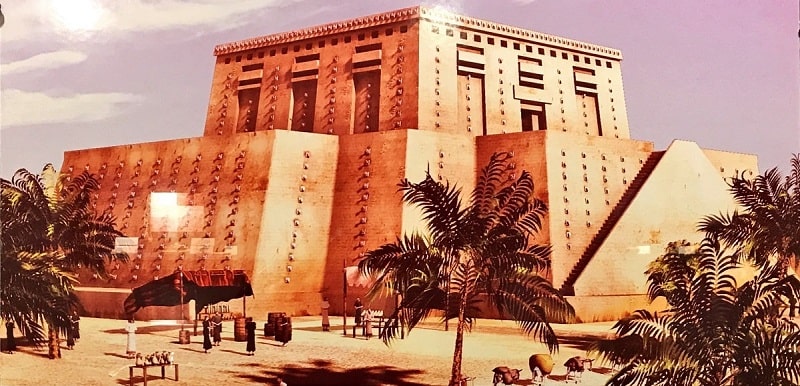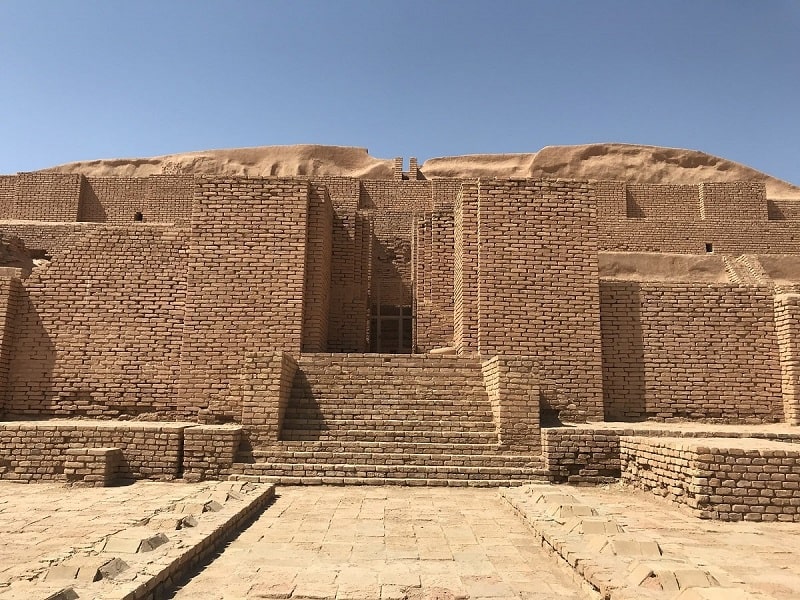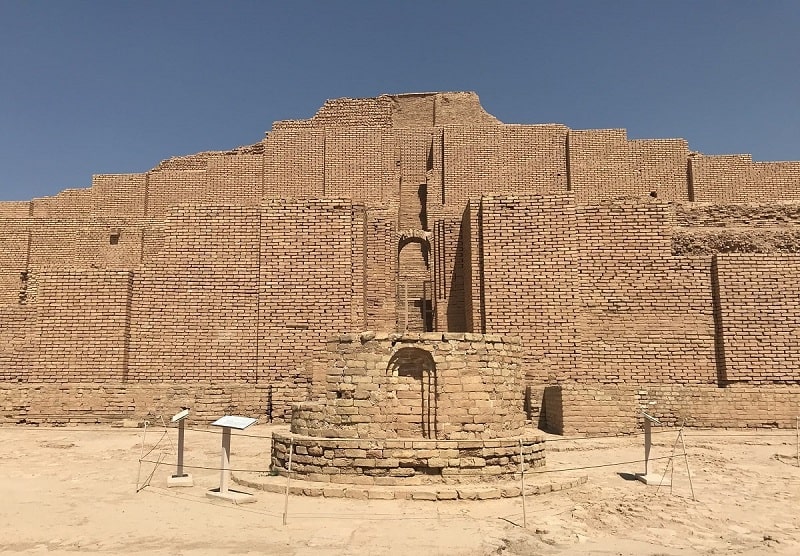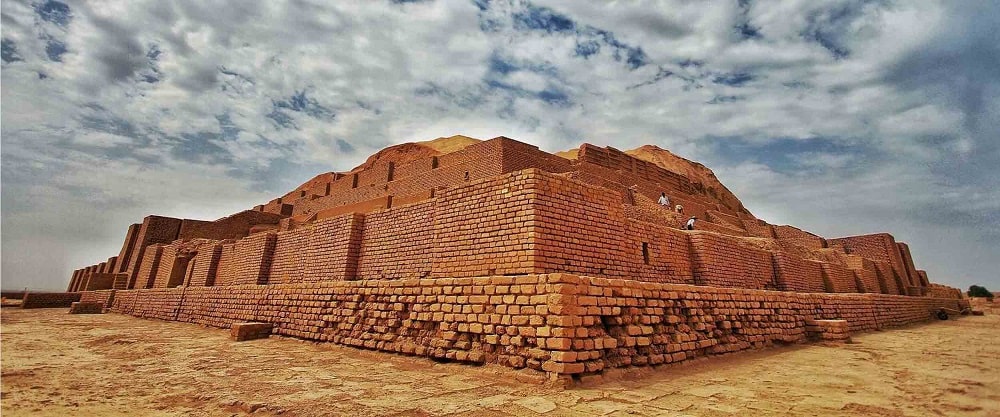Introduction to Tchogha Zanbil Ziggurat
Temples are among the most mysterious and phenomenal places people build to worship, pray and celebrate holidays. People used to construct those places on high locations such as mountains or high hills to be close to the universe and gods. Temples were full of decorations and symbols or tools for worshipping or communication with the universe. So mysterious that even after years of research, some questions about them remain unanswered.
One of the highest shrines built by the West Asian civilization for the gods was the pyramidal ziggurats, which people used to elevate spirituality to the heavens. Ancient Persia was not deprived of these cultural elements, because the Tchogha Zanbil Ziggurat, one of the largest ziggurats; is located in the Mesopotamia zone.
According to the obtained documents, the Tchogha Zanbil Ziggurat is one of the oldest cities in Persia. For a long time, Susa has been the flourishing centre of many civilizations, including the Elamites and Achaemenids. The Tchogha Zanbil Ziggurat, the remnant of a civilization that was buried by the enemy’s violence, came out of the heart of the warm soil after passing many years to narrate a complete story of history.
History of Tchogha Zanbil Ziggurat
In the 13th century BC, Ontash Gal, king of ancient Elam, built a holy city named “Duravantash”. “Far” means home and city. “Tchogha” also means hill in the local language, and Zanbil means basket, so Tchogha Zanbil means basket hill. Tchogha Zanbil Ziggurat was in the city centre as a place of worship. This place of worship was in the highest part of the city.

The usage of a mysterious temple
The Duravantash ziggurat was to worship the goddess of Susa, Inshushinak. The city of Susa, which was the ancient capital of Ilam, was about 30 kilometres away from this holy city, and caravans could travel around it for a day. This made the holy city of Duravantash very popular. The ziggurat was built as the guard of the city of Susa, which unfortunately was ruined by the order of Banipal (one of the kings of the time) before it was completed. In an inscription found Banipal explained how he destroyed the ziggurat: “I broke the ziggurat of Susa, which was glazed with bricks with azure stone. I destroyed the structures of Elam and turned Susa into a ruin. By destroying the ziggurat the voice of humans and the sound of joy disappeared from there.

Tchogha Zanbil Ziggurat cuneiform bricks stories
On the walls of the temple there are cuneiform bricks, all of which have the same text and express the name of the king and his purpose in building the temple. Tchogha Zanbil ziggurat was the place to worship the Elamite gods. It is the largest ziggurat in the world outside of Mesopotamia. The difference between Tchogha Zanbil Ziggurats and Mesopotamian ziggurats is that the upper classes of ziggurats were built on the lower floor. In Tchogha Zanbil ziggurats are such that all classes have separate foundations, and all of them are based on the ground floor. Tchogha Zanbil ziggurat represents the beliefs, culture, and traditions of the tribal traditions of one of the oldest Persian civilizations.
Roman Krishman found Tchogha Zanbil Ziggurat
It was buried in the ground for a long time, therefore it took the shape of a hill until it was buried by a Frenchman named Roman Krishman. During the search, archaeologists were able to find a petroglyph that dates back to the Elamite period with an interesting picture on it. A picture of a woman with a fishtail holding snakes. This valuable relic of history and Persian culture, which represents the millennial civilization of Persia, like many other historical monuments, is not kept in this land and is kept in Louvre Museum in France.
The architecture of Tchogha Zanbil Ziggurat
One of the oldest civilizations in West Asia. In this civilization, a special method of architecture was used to build religious monuments such as places for worship. Most of the religious structures at that time were pyramidal. These pyramids were built in the form of stairs and were made of bricks, which are called Ziggurat. The reason why these shrines are in the shape of pyramids is that they could take humans closer to heaven and then to God. This method of making ziggurats had been common for more than 4000 years ago.
The building was built on five floors and is 52 meters high, of which only two and a half floors, 25 meters high, remain. The fifth floor was considered the tallest floor and only the priests and the royal family were allowed to enter it. This floor was also considered to be the place of the god of the city of Susa. The best materials are used in making ziggurats. They have prepared the best bricks and clay so that they can build such buildings. The number of these buildings is not small, but certainly the best and less ruined of them is the Tchogha Zanbil Ziggurat, which is located in the city of Shush. This ziggurat is now famous not only in Persia but all over the world.

Features of Tchogha Zanbil Ziggurat
The unique element of such temples is that they seem like stairs because the upper floors are smaller than the below ones. In ziggurats, people used to keep the statues of gods and hold religious ceremonies. Acadians call it “zikurto”, Sumerians call it “ziggurat” and the Elamites call it “zikurto”. Because Roman Gershman, the French archaeologist who discovered this building, referred to it as “Ziggurat” in his articles, it is also called such in Persia. People derived the word “ziggurat” from the verb “ziggurat” meaning “to rise and rise”. Tchogha Zanbil Ziggurat is a remnant of a civilization buried in the heart of the enemy with violence and violence to tell a complete history years later.
Discoveries of Tchogha Zanbil Ziggurat
Sunshine clock
There are three columns in the Tchogha Zanbil ziggurat to determine the time of sunrise and sunset, days, seasons and years. For this purpose, the Elamites built it as the first sundial in history and used it.

Remains left on pavements
The floor of the Tchogha Zanbil ziggurat area has been designed with paving stones, and the remaining traces which are the footprints of children who passed, are among the interesting discoveries of this building.
Written bricks and inscriptions
There are usually writings on ziggurats which tell the story of the ziggurat and its maker. There are about five thousand brick inscriptions in this building, which are handwritten and do not use stamps or molds. The Elamites used these lines to beautify the space. Around the ziggurat building, there are bricks with Elamite cuneiform inscriptions that include the name of the builder and the purpose of the building. It is interesting to know that the oldest tiles in the world have been discovered Tchogha Zanbil Ziggurat. These ziggurats are glazed and others have decorations such as studs.
An inscription from Ontash, the builder of Choghaznabil, was found in this huge structure with this inscription: I engraved the golden bricks of Ontash Gal, I built this shelter here for the gods of Gal and Inshushinak and gave this sacred place as a gift. May my works be accepted by the god’s Gal and Inshushiank as gifts.
Tchogha Zanbil Ziggurat regulatory plant
The Tchogha Zanbil Ziggurat refinery to the west of the main temple, along with related vessels, is the world’s oldest refinery. Unfortunately, there is nothing left from the enormous doors with decorations of glass bars but the stone heels of these doors could be seen in a corner of the compound. Archaeological evidence shows that there were giant bull-shaped statues next to these gates, which were the guards of the ziggurats. Fragments of these pottery cows were found in the ziggurat area.
Near the third fence of the ziggurat, on the southeast side, the remains of the palaces of the Elamite kings and their tombs are placed. It is interesting to know that there are five underground tombs along with works such as glass ornaments discovered. This place could be considered the eternal abode of the Elamite kings. French archaeologists took Some of these works in the Qajar era.
Specifications of Tchogha Zanbil Temple marking name
The ancient name for this “Tchogha Zanbil” is the world assembly. “Chugha” as “hill” and Zanbil as “basket”. In fact, the appearance is different like an overturned basket. The law of the Bastans is that “far-Ontash” that the “Ontash Fortress” of the Elamite king succeeds.
The Middle East and Africa Book on the Ziggurat
Tchogha Zanbil ziggurat with the modern name around Ontash or El Ontash is an Elamite city that operated in the pre-Christian years. Thewas around the capital of the Elamite Kingdom to which it can be assigned.
Tchogha Zanbil in UNESCO World Heritage
Tchogha Zanbil Ziggurat is the provider of the most amazing pyramid in the history of Persia. It is the greatest ziggurat in Mesopotamia, so UNESCO added the sight to the UNESCO World Heritage List in 1979.

UNESCO World Heritage criteria of Tchogha Zanbil Ziggurat
Tchogha Zanbil ziggurat corresponds to two UNESCO criteria:
Criterion (iii): The ruins of the Tchogha Zanbil Ziggurat, next to the historic city of Susa, are the only evidence of the architecture of the Middle Ages of the Elamite Empire (1400 to 1100 BC).
Criterion (iv): Tchogha Zanbil Ziggurat is the largest building of its kind outside of Mesopotamia to this day.

Location of Tchogha Zanbil Ziggurat
Tchogha Zanbil Ziggurat complex lies in the west-south of Iran in Khuzestan Provins. It is 40km far from the ancient city of Susa. The building is in the heart of a warm, dry and vast place with a dazzling view of the Dez River.
What the past says
“After obtaining the building materials, I set up the city of Ontash and the sanctuary here and enclosed it in an outer wall and an inner wall,” Ontash Gal said about the construction. “I built a tall temple that did not look like what the kings had built, and I dedicated it to the god Inshushinak and the god Humban of the sanctuary. May my building and hard work endowed with them, and the grace and justice of Humban and Inshushinak remain here.” Regarding the great devastation he left, Banipal recounts: “I broke the ziggurat of Susa, which glaze with azure bricks, and razed the Elamite structures to the ground. I turned Susa into ruin, and the human voice and the cry of joy disappeared from my hands.”
Where to stay near Tchogha Zanbil Ziggurat
Nasr Susa Hotel
Nasr Hotel has provided you with all the facilities of comfort and convenience, and in the restaurant of this hotel, you can experience tasting the authentic Khuzestani dish of Gheliyeh Mahi
Ahura Daniel Campus Residence
The residence and dining hall, named after the Ahura Daniel Campus (Daniel’s Paradise of God), is a two-story old house in Susa near the historic castle of the city and museum.
Abu Ali Ecological Residence
It is located in the village of Khamat Haft Tappeh in the city of Shousha.
Apadana Shush Hotel
This residence is one of the 1* hotels close to the city center with good access to the historical monuments of Shush and the distance from the hotel to the ziggurat complex is 43 minutes by car.
Where to eat near Tchogha Zanbil Ziggurat
Anargol Traditional Restaurant
This restaurant is built on two floors in the city of Susa with a traditional design.
Shabestan Restaurant
Another good restaurant in Shushtar serves delicious local food. The nave is traditional and is designed as a dining room.
Ziggurat Restaurant
This well-qualified restaurant is located in the city of Susa and is also facing Apadana Castle.
When to visit Tchogha Zanbil
In spring, summer and autumn, the weather is hot and dry, and to some extent, it bothers you. But in winter, the weather is mild and springy, which is why it is the best season to visit this area. Bring a hat and sunglasses, drinking water and sunscreen, as well as a fan and a variety of cooling devices with you on this trip.
How to go to Tchogha Zanbil
The distance from Tehran to Susa is about 700 km. There is no other direct route to reach this historical city except for private cars and buses.
Some travellers get the train to the ziggurat. Others by car to Shush, and after 2 hours of driving on the side road of Haft Tappeh, you will reach The Ziggurat. Or to access and visit this Ziggurat, you can drive to Khuzestan province and beyond, drive to Shush and then to Karun Road. The nearest airport to the city is Dezful Airport, 25 km from Shush.
Local Airport
If you want to go to Khuzastan fast way, you can take a ticket for Tehran- Ahvaz flight. And if you want to go to other cities in Khuzestan, take one of the taxis around the Ahvaz Airport(AWZ). The Airport is one of the most important airports in the southern part of the country.
How to visit Tchogha Zanbil
To capture beautiful images of this amazing collection, let’s stay until sunset in the area. The beautiful sunset in the sky creates a beautiful view for photographers. Also when it gets dark, the lights around the temple turn on and a beautiful light shines. With these lights, it shows its dignity. Also, the museum and the ancient area are the weekly hills that you can visit.

